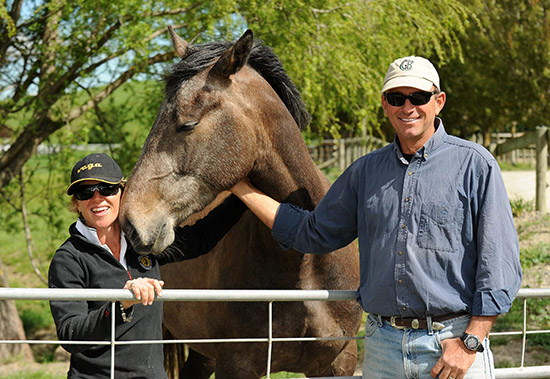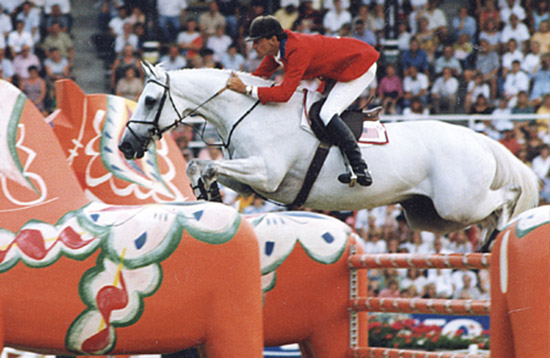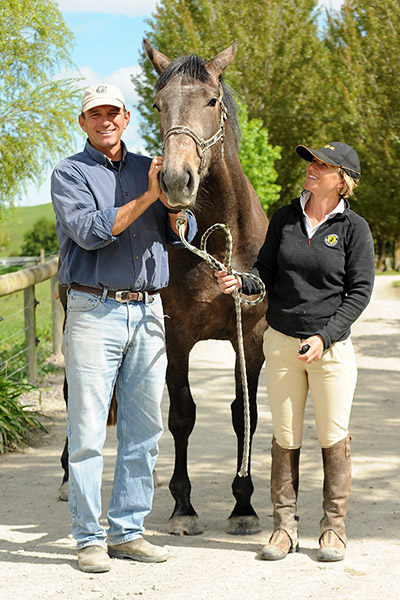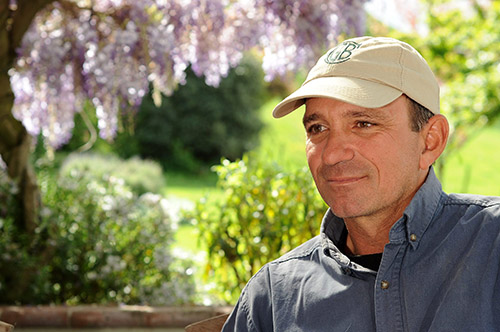When he’s not busy coaching in the States, Olympic silver medallist Greg Best is happiest out of the spotlight, quietly living the Kiwi dream in sunny Hawke’s Bay, as Helen Firth discovers
Anybody who has had the pleasure of meeting Greg Best will find it astonishing that such a warm, charming character longs to be left alone and quietly get on with being a farmer and husband. Because this incredibly talented coach and rider with two silver Olympic medals to his name could so easily be living a much more public life; could so easily have continued at the top of the game, yet walked away from it all at the age of 28 and now says he’ll probably never return to top level show jumping.
As a coach, Greg is magic, pure and simple. He is an educated theorist and has an uncanny ability to analyse, empathise and communicate with riders of all skill levels, from pony club kids through to Grand Prix. Greg’s aim is to make every student walk out of the arena feeling as though they’ve just had the best lesson of their life, and having watched him teach I bet it’s a rare day when this doesn’t happen. Sadly, few Kiwis have the opportunity to train with Greg anymore: when he’s at home at the idyllic 1000-acre Otane-based Silverstream Station he shares with his wife, Kim Best, Greg doesn’t really teach.
This is largely because for six months of the year Greg is on the road giving clinics in the US: it is financially lucrative work, but draining, to the point he barely wants to glance at a horse at the end of it. When he’s at home, he longs to be a ‘weird recluse’ and enjoys watching five-day cricket test matches; he explains it’s a result of all the pressure and intensity he feels when he’s coaching. “When I’m teaching in the States, people are at me 24 hours a day. They want to extract every bit of knowledge they can during the day and then rehash it again at night and go out to dinner and drink. I have a contract now that says I won’t do all that social stuff – I feel like Britney Spears sending them my contract ahead of time,” he jokes.
The relatable coach
During his precious months at home, Greg doesn’t give many lessons, with the exception of a chosen few, including his wife Kim, and top rider Oliver Edgecombe. Besides the fact he needs to recuperate, there is also a cultural aspect which comes into play, he feels.
“For sure, there is a money aspect to it, but there’s got to be something else, too. There’s a culture of people wanting to learn in America; in New Zealand I think there’s a culture of affirmation. Over there, people are really good learners and are enthusiastic about the process of learning, whereas here, though you come across a handful of riders who make you want to teach them, many more people are there to be told that what they are doing is right.
“One of the reasons I don’t love doing squad training is because a lot of the time people are there only because they are told to be, and it’s frustrating. There are so many people in the world who are hungry and desperate for knowledge.”
While on paper, the above quotes might make Greg sound a touch egotistical, nothing could be further from the truth. He’s a pretty humble guy, as he reveals when talking about his crippling injury, sustained in a fall many years ago. That fall, from his legendary horse, Gem Twist, shattered every bone in his shoulder, and he’s had several surgeries on it since. For a long time, his shoulder hurt but he could still ride. More recent surgery took away the pain, but it’s also left him with an arm that essentially doesn’t work. He can’t ride properly, and doesn’t know if he ever will be able to again. He is awaiting an appointment with his surgeon to find out if anything can be done, but until then is living in limbo, ‘in that space where I don’t know what is possible.’ However, whatever the outcome, he thinks the competitive drive to ride at the top level again has disappeared.
“I haven’t really ridden regularly in five or six years, and at the age of 47 it is hard to get back into it,” he says. “It’s a very strange thing, because there is an expectation that I should be able to go out and do it. The knowledge is still there, because I teach so much, but the physical skills aren’t there. I’ve ridden three times since I’ve been home, and one of those times I got bucked off, because I don’t have the ability to react and physically I’m too weak.
“I literally had not jumped a fence in 18 months when I got on a horse the other day, and jumped a couple. I never missed, but I was so self-conscious and unsure the whole time I was doing it. From a teaching point of view, it’s actually been useful, because when I tell a person I can relate to how they are feeling, the anxiety and not being confident, I really mean it.”
A silver start
Greg was born in Virginia, US, and for the early part of his life lived on the east coast of America, and went to university in Philadelphia. His mother rode, and both Greg and his younger sister, Leigh-Ann, started on ponies when they were pre-schoolers, competing on the lead line. Greg had a lot of success in the show hunter ring, winning the coveted national pony show hunter final three times. “The pony show hunter stuff was when I hit my peak. It was all sort of a slippery slope form that point on,” he laughs.
Although Greg’s family were horsey, they certainly weren’t wealthy, but from the age of 15, Greg was lucky enough to train with the legendary Frank Chapot, who rode at six Olympic Games and won two silver medals. “He lived up the road and he was a guy who didn’t really teach anybody, but my mother just badgered him until he gave in. My mother was a real driving force in the early days.”
Greg and Gem Twist at the 1990 WEG in Stockholm
Greg didn’t have any horses of his own at that time, but rode at Frank’s every day. Frank had ridden an international show jumping stallion called Good Twist and bred many horses by him, including Gem Twist. Greg teamed up with Gem when the horse was five years old. The beautiful 16.2hh grey thoroughbred was not your typical thoroughbred, says Greg: he moved more like a warmblood, was scopey, sassy, reactive and difficult. Gem was originally sold to Michael Golden as a pleasure horse, but he was no pleasure to ride and Michael quickly returned him! However, Michael did retain ownership of the horse throughout his career.
Gem Twist was Greg’s first Grand Prix horse, and they accelerated through the ranks, going from rookie to Olympian in 18 months. They famously won double silver at Seoul in 1988 and were fourth at the WEG in Stockholm, 1990, where Gem Twist was the best horse, accruing the least faults over four rounds with four different riders.
Gem Twist is the only horse to have been named the American Grand Prix Association ‘Horse of the Year’ three times (once with Greg, then later with Leslie Howard and Laura Chapot). He retired from competition in 1997, and was euthanized in 2006 at the age of 27.
Giving it all away
Greg’s world changed profoundly in 1992. In the June, he and Gem Twist were disqualified from the Olympic selection process when they were freakishly eliminated at a qualifying show. “There had been a lot of rain and the horse couldn’t figure out where the puddles ended and this double of Liverpools began, and he stopped three times in the combination,” recalls Greg. “At that time, if you were eliminated at one of the qualifiers, you were eliminated from the qualification process altogether.”
In July that year, Greg’s mother died, and then just a couple of months later he suffered the crashing fall from Gem which shattered his shoulder. It was the end of the dream for Greg, who packed his bags and moved to Florida, away from Gem, who was then ridden by Leslie Howard, to begin a new chapter in his life.
“When I broke my shoulder, I just realised this wasn’t for me any more,” he recalls. “I was riding the best horse in the world, but I didn’t care about that. Gem was always offered back to me, if I wanted to ride him again, but it didn’t mean that much to me. I just thought there had to be other things in the world that were more interesting and stimulating than going out and doing the same shows every year.”
Becoming a Kiwi
Greg moved to New Zealand in 1994, after meeting Kiwi show jumper Claire Wilson. Claire worked for Greg’s neighbours in Florida, and after Greg and Claire became friends, he followed her back to Waipukurau to visit. He enjoyed the anonymity New Zealand provided as well as the change of scenery and stayed; by 2001 Greg had become a bona fide Kiwi citizen.
“When I was living at Claire and [her mother] Di’s place I did ride horses, but it was more to chase sheep and cattle and go fix fences. I was just a farmhand at their place for a couple of years, and more than anything I liked that it was the complete opposite of everything I had just lived for the past five years, the crazy insanity of all the stuff that happened,” he explains.
Greg soon started to settle into the New Zealand show jumping scene, but he says the local riders certainly weren’t in awe of him. If anything, it was very much the opposite; they kept him at arm’s length socially, although he was constantly being offered horses to ride. Then, the Lillejords, an American family, sent him their impressive US-bred Selle Francais, Entrepreneur. Greg and Entrepreneur won the NZ World Cup series and it was a hugely promising partnership, but eventually the money dried up and the horse was sent home.
It seems amazing that Greg was never tempted to chase the Olympic dream again, never wanted to play the role of American Olympic hero, but truthfully, he says, it was never him. “For sure the riding and the coaching is what defines me as a person from the outside looking in, but the riding and the horse aspect of my life is not the way I see myself. It’s what I’m known as, and what affords us to have all of this,” he gestures around at his home. “But if I could have my way, I think I would be this funky weird recluse, who wouldn’t make it off the farm very much.”
The next chapter
Greg married fellow show jumper Kim (nee Zander) four years ago; they were together for eight years prior to marrying, and good friends even before that. Kim, 34, who is originally from Otaki, is one of the country’s best producers of young horses and also a popular trainer in her own right.
As a pony rider, Kim twice finished second in Pony of the Year aboard the famous pony Skylight. Still alive at the grand age of 34, Sky is now chief babysitter of the Bests’ foals. Kim also competed successfully at World Cup level on Jetson (later sold to the States) and even won a National Grand Prix Championship. Despite this, she describes herself as a ‘has been’. “I would like to (jump Grand Prix again), but I’ve been out of it for a long time now and the jumps look big! And we keep selling our young horses.”
Kim and Greg have a successful small breeding programme of diverse lines, and have bred and produced several good young horses, including IQ (winner of the four-, five- and six-year-old championship at the national young horse show), Clifton Zander (winner of the NZ National Three-Day CIC* in 2011), Clifton Bee Gee (winner of the Puhinui Young Event Horse Championship then sold to the UK) and Kim’s current rides Mr Wiggle and Giggles. Kim clearly loves the young horses, and is extremely grateful to their sponsors, who help keep the show on the road. “We’ve had Mitavite, Zilco and Vetpro behind us for more than 10 years, and the Tack Shop is a new sponsor. We couldn’t do it without them; they are so generous and never ask for anything.”
The latest project for Kim and Greg is developing Greg’s training website, www.gregbestclinics.com, where subscribers can watch training videos on such a diverse range of subjects as position, flatwork for young horses, how to tighten your girth properly when mounted or how to fix a horse that’s crooked. The website will primarily be targeted at the American market, and the couple has been busy putting videos together, some of which Kim was the model for.
Kim is one of the few people Greg finds it hard to say no to when it comes to coaching, and he says his wife has an incredible attitude. “When we walk out into that ring it’s not husband and wife, it’s student and teacher. She never questions anything that I tell her, and walking out of the ring, without fail, she says thank you. She’s amazing.”
Greg: Fact File
Born: 23 July, 1964, Virginia
Education: degree in economics
Won: Team and individual silver at the Seoul Olympic Games, 1988; 4th at WEG in Stockholm, 1990
Moved: To New Zealand in 1994
Has held: Official roles for New Zealand Show Jumping and Eventing, including coach, team manager, chef d’equipe, selector and high performance manager
Greg on:
Training horses
A lot of people have this very generic approach to riding horses, that every rider should ride every horse the same way. I don’t believe in a cookie-cutter approach, that every horse needs to come out and do the same exercises. Horses are all unique individuals and not every horse should have the same routine: they need to be fed differently, schooled differently and prepared differently for the classes. If you have a really intense Type A personality riding a very passive horse, you have to deal with that combination differently than if we were talking about the reverse.
On coaching
For a very short period of time, I try to live that rider’s life and understand what’s going on in that rider’s head, feel what that rider feels underneath them.
I teach a lot of little pony club kids, eight to 12-year-olds learning how to jump, and at almost every clinic I do there will be a group of young horses who have barely jumped before. All I really care about when I’m teaching is that I have people who are interested in the process of learning.
Being a trainer who doesn’t ride
Riding used to be a big part of my teaching; I would ride at least half a dozen horses in a clinic, but it’s evolved into a different type of teaching out of necessity. I think in fact you’re a better instructor if you can do it without getting on the horse, because the riders are the ones who need to solve the problem. Sometimes by riding you can expedite the process, but what you’re doing is fixing the problem, then the original rider just has to get on and not screw it up again. There’s a great amount of satisfaction in the rider figuring how to fix it in the first place; satisfaction on their part, and on my part too.
His favourite horse
Santos. He was the second highest qualifier for the Seoul Olympics in 1988 (Gem Twist was the top qualifier). Santos was a Holsteiner and the total opposite of Gem: he was little, and not that talented, but he had a heart of gold and would do anything for me. I was able to jump him over a single orange road cone, to a single road cone to a single road cone. He was only 15.3hh and I jumped him over 7’2’’ a couple of times, tried 7’6’’ a couple of times and didn’t succeed, but he never stopped or questioned anything I ever asked him to do. Without a doubt, he was my favourite horse of all time.
His silver medals
It was meteoric success, just crazy. It was mind-blowing to me, because when I was a kid, the most expensive horse my parents ever bought me was $90. So that was probably the most unconventional part of the whole process: we had no money, no expectations.
Gem Twist
He was not that impressive to ride at home: blobby, unenthused and moderately careful. But the bigger the show ring, and the more people watching, the better he was. Racehorse people will say that some horses are really competitive, they just seem to know, and Gem was one of those horses. And he was careful. Genuine carefulness is a rare thing. Perhaps one horse in a hundred jumps higher the more times you jump something, and he was one of those horses. The better he understood it, the better he jumped, whereas 99% of horses are impressed by a fence the first time they do it and get lower and lower.
Thoroughbreds
It’s hard to get a good thoroughbred here. It seems the ones you get off the track are little and just not very nice types – I think the best ones head off to Australia or Hong Kong. But when I go to America, invariably the nicest horse I see every year will be a thoroughbred, and it will be 17.1hh, 17.2hh, with this lovely, big 13-foot stride, but you wouldn’t recognise it as a thoroughbred here. I love thoroughbreds; they never seem to hit bottom and I understand them, grew up riding them.
This article originally appeared in the February 2012 edition of The Horse Magazine




